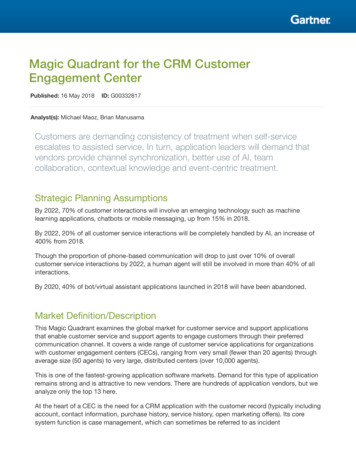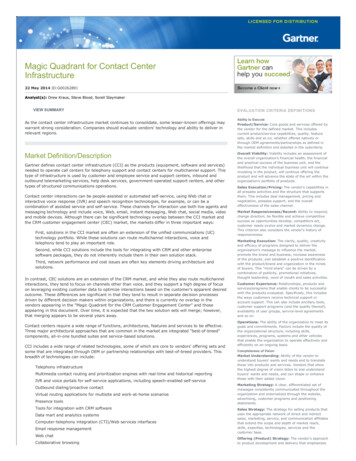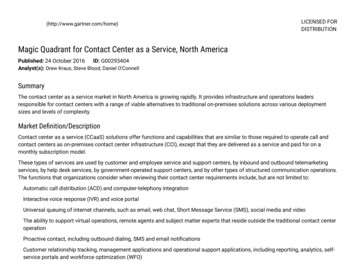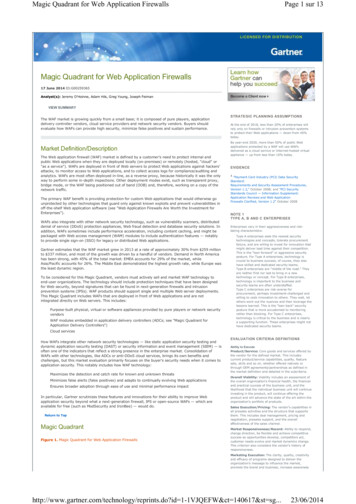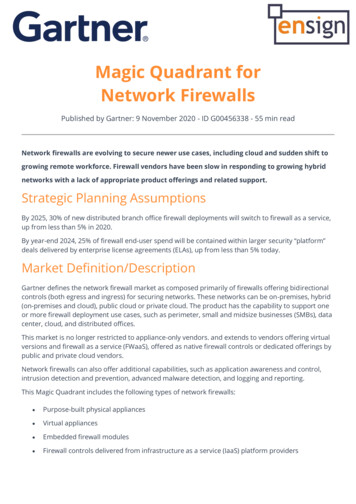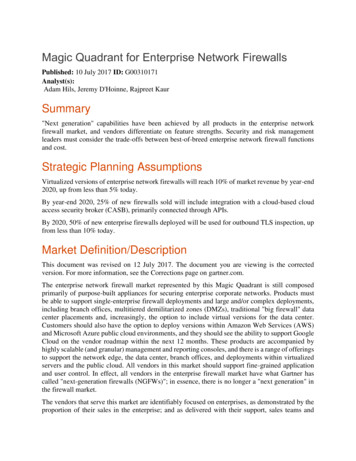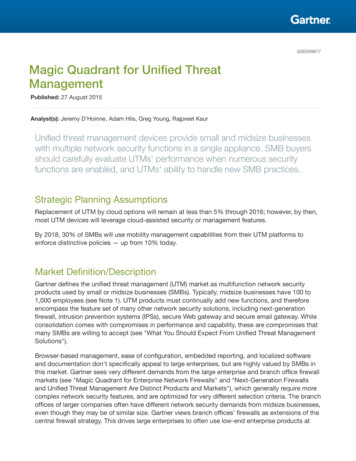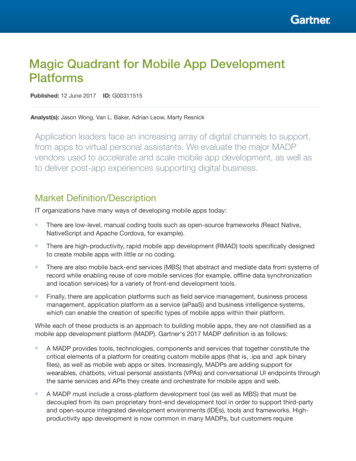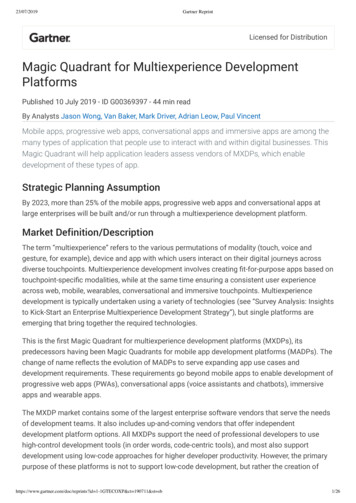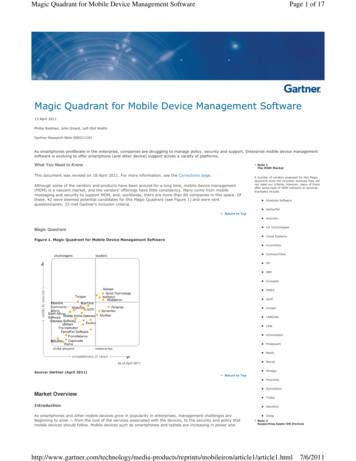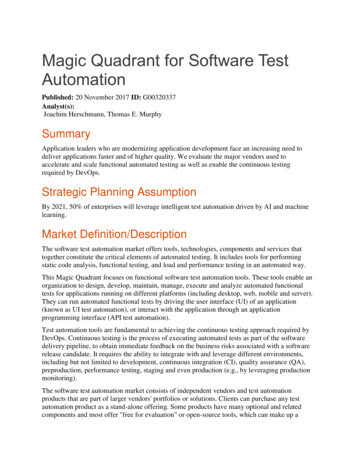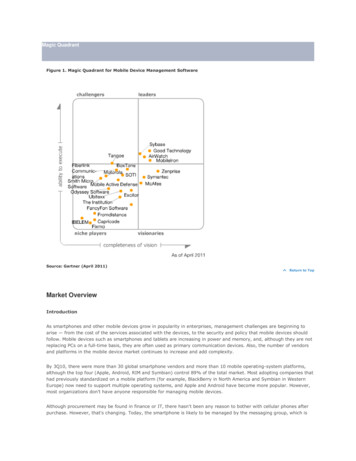
Transcription
Magic QuadrantFigure 1. Magic Quadrant for Mobile Device Management SoftwareSource: Gartner (April 2011)Return to TopMarket OverviewIntroductionAs smartphones and other mobile devices grow in popularity in enterprises, management challenges are beginning toarise — from the cost of the services associated with the devices, to the security and policy that mobile devices shouldfollow. Mobile devices such as smartphones and tablets are increasing in power and memory, and, although they are notreplacing PCs on a full-time basis, they are often used as primary communication devices. Also, the number of vendorsand platforms in the mobile device market continues to increase and add complexity.By 3Q10, there were more than 30 global smartphone vendors and more than 10 mobile operating-system platforms,although the top four (Apple, Android, RIM and Symbian) control 89% of the total market. Most adopting companies thathad previously standardized on a mobile platform (for example, BlackBerry in North America and Symbian in WesternEurope) now need to support multiple operating systems, and Apple and Android have become more popular. However,most organizations don't have anyone responsible for managing mobile devices.Although procurement may be found in finance or IT, there hasn't been any reason to bother with cellular phones afterpurchase. However, that's changing. Today, the smartphone is likely to be managed by the messaging group, which is
responsible for the BlackBerry Exchange Server (BES), rather than by the entity responsible for managing computinghardware. Although many companies may have device management responsibilities, usually for hardware such as PCs orphones, current software doesn't really cover mobile devices, nor is IT staff trained to support handheld devices.Elements of MDMAlthough many companies are trying to solve a similar problem, it takes multiple types of mobile software to address afull solution. A fully managed mobility solution cuts across standard MDM and telecom expense management andincludes: Software Distribution — The ability to manage and support mobile application including deploy, install,update, delete or block. Policy Management — Development, control and operations of enterprise mobile policy.Inventory Management — Beyond basic inventory management, this includes provisioning and support.Security Management — The enforcement of standard device security, authentication and encryption.Service Management — Rating of telecom services.ConclusionThe MDM market is quickly evolving. The requirements and definitions are changing rapidly, and vendor offerings willevolve quickly and be even more capable and mature by next year. High demand is creating a frenzy of development, aswell as hope. Although many of the successful MDM providers have focused almost exclusively on mobility, during thenext few years, those managing PCs will also be investing and looking for opportunities in the MDM space. Most vendorsnow offer on-premises or software-as-a-service (SaaS)-based tools, and more-mature managed service offerings willemerge during the next three years to drive growth in the industry.Some key things to keep in mind when assessing an MDM vendor are: Some of the device platforms will limit manageability, due to inherent manufacturer design — don't expectMDM solutions to address each platform the same way or support it the same way. Android support is still immature — it will be another year before Android is well-supported by most MDMvendors. BlackBerry support is still important — not all MDM vendors support BES integration. It is important thatBlackBerry support continues, because, in many regions, it is still the most-supported enterprise device, evenas other platforms take away market share. MDM tools won't beat the BES, but should be able to help manageand report on BlackBerry devices. Don't underestimate reporting — for some vendors, their reporting and business intelligence (BI) tools aresimple if they have them at all. Reporting on device status will be a critical component, and vendor capability to offer both text and graphicalreports, canned and customized, is critical.With the advent of new devices, the MDM market is growing quickly. If we assess pure MDM revenue (excluding revenuefor messaging, security, etc.) year-end 2010 is estimated at 150 million, increasing at a compound annual growth rate(CAGR) of 15% to 20% during the next three years.Market Definition/DescriptionEnterprise MDM products and services help enterprises manage the transition to a more complex, mobile computing andcommunications environment by supporting security, service, software and inventory management across multipleoperating-system platforms, primarily for handheld devices such as smartphones and tablets. To meet Gartner'sdefinition, MDM vendors must address at least three of the four "elements of MDM" set forth in the market overview andsupport MDM capabilities or features in mobile application platforms, with an emphasis on MDM. Rated vendors aregenerally expected to be able to respond competitively with respect to the following features and functions.
Inclusion and Exclusion CriteriaGartner is aware of more than 60 vendors that claim some level of play in MDM on a global basis. In most markets, evengrowth markets, large numbers of competing vendors with similar products are cause for concern and indicate a need forcompetitive natural selection and consolidation.Inclusion CriteriaAfter due consideration, 23 vendors were selected to be included for ranking in this Magic Quadrant. The followingcriteria are necessary for inclusion: Support for enterprise-class (noncarrier), multiplatform support MDM: software or SaaS, with an emphasis onmobility Specific MDM product focus and feature set or a primary focus on MDM in another product set (messaging orsecurity) Security management, with at least these features: Remote lockAudit trail/logging"Jailbreak" detectionPolicy/compliance managementSoftware distribution, with at least these capabilities supported:Application downloaderApplication verificationApplication update supportApplication patch supportInventory management, with at least these capabilities supported: Device wipeAt least mobile OS 3 platforms supported Enforced passwordExternal memory blockingConfiguration change historyManaging at least 25,000 mobile linesFive referenceable accountsAt least 1 million in MDM-specific revenueExclusion CriteriaMDM companies not included in this Magic Quadrant might have been excluded for one or more of these conditions: The company did not have a competitive product on the market for a sufficient amount of time during calendaryear 2010 and the first quarter of 2011 to establish a visible, competitive position and track record. The company had a minimal apparent market share and low market inquiry interest among Gartner clients.The company was invited to participate, but did not reply to an annual request for information and did nototherwise meet the inclusion criteria. Alternative means of assessment, particularly client requests andcompetitive visibility, did not meet the inclusion criteria.The large number of vendors claiming presence in this market makes it impossible to include every company. Vendorswere individually reviewed, discussed and selected by a team of analysts.Added
This is the first Magic Quadrant published for this market, so all vendors referenced are new to this research.DroppedThis is the first Magic Quadrant published for this market, so there is no history of vendors dropped.Return to TopEvaluation CriteriaAbility to ExecuteGartner analysts evaluate technology providers on the quality and efficacy of the processes, systems, methods orprocedures that enable IT provider performance to be competitive, efficient and effective, and to positively affectrevenue, retention and reputation (see Table 1). For MDM, this involved providing on-premises-based or SaaS capabilitywith the required number of features to manage the software, security and inventory of a midsize or large (more than1,000 devices) organization. Although global scaling is important, there should be significant domestic or regionalpenetration at leading companies.Table 1. Ability to Execute Evaluation CriteriaEvaluation CriteriaWeightingProduct/ServicehighOverall Viability (Business Unit, Financial, Strategy, Organization) highSales Execution/PricingstandardMarket Responsiveness and Track RecordstandardMarketing ExecutionstandardCustomer ExperiencehighOperationsstandardSource: Gartner (April 2011)Return to TopCompleteness of VisionGartner analysts evaluate technology providers on their ability to convincingly articulate logical statements about currentand future market direction, innovation, customer needs and competitive forces, as well as how they map to the Gartnerposition. Ultimately, technology providers are rated on their understanding of how market forces can be exploited tocreate opportunity for the provider. MDM providers should have a significant vision (see Table 2) on the evolving market,including software delivery methods, innovative and differentiated features, geographic expansion, as well as distributionand technology partnerships.Table 2. Completeness of Vision Evaluation CriteriaEvaluation CriteriaWeighting
Market UnderstandinghighMarketing StrategystandardSales Strategyno ratingOffering (Product) StrategyhighBusiness ModelstandardVertical/Industry Strategyno ratingInnovationhighGeographic StrategystandardSource: Gartner (April 2011)Return to TopLeadersLeaders demonstrate balanced progress, effort and clout in all execution and vision categories. If they do not dominatein sales, they are, at a minimum, the most critical competitive threat to their peers in open competition. A leadingvendor is not a default choice for all buyers, and clients are warned not to assume that they should buy only from theLeaders quadrant. To stay on the right side of the chart, Leaders (and Visionaries) must offer features that removesignificant roadblocks to the complex challenges enterprises face when attempting to treat mobile consumer devices asbusiness tools. One example of a competitively disruptive activity might include delivering a sandbox method to preventdata leakage between personal and business applications.Return to TopChallengersChallengers have attractive products that address the typical baseline needs for MDM with competitive visibility that isstrong enough to demand attention in RFPs. Challengers may win contracts by competing on a limited selection offunctions or a limited selection of prospect buyers by industry, geography or other limiting factors, even if, on spec, theirproducts have broad functions. They may be perceived as a threat by other vendors, but that threat will be primarilyfocused on a limited class of buyers, rather than the MDM market as a whole. Challengers are efficient and expedientchoices for defined access problems.Return to TopVisionariesVisionaries are able to demonstrate long-term strategies for MDM that point to the product and service approaches thatwill be most competitive in the future. Visionaries might affect the course of MDM, but they lack the execution influenceto outmaneuver Challengers and Leaders. Buyers may pick Visionaries for best-of-breed features, and for broaderinfrastructure investments than Niche Players. Smaller vendors may take risks on potentially disruptive technologies,while larger vendors may be in the process of building out their next-generation portfolios. Buyers of Visionaries'products may base their selections on specific technology features and by participating in the vendor's road map.Return to Top
Niche PlayersNiche Players meet the typical needs of buyers and fare well when given a chance to compete in a product evaluation.Niche Players generally lack the clout to change the course of the market. They may offer an uncommon deliverymechanism for products and services. They may rely on a self-limiting business model, and/or have limited influenceoutside of a particular industry or geography. Niche Players may target clients that, for various reasons, prefer not tobuy from larger network players. In many Gartner market studies, buyers report that Niche Players tend to provide morepersonal attention to their needs.Return to TopVendor Strengths and CautionsAirWatchFounded in 2003 and based in Atlanta, Georgia, AirWatch emerged from the wireless network management services andruggedized device market, where management SLAs are critical. AirWatch puts emphasis on device status monitoringand help desk controls. AirWatch support is offered for Android, iPhone, iPad, Nokia S60, full Windows (PanasonicToughbooks), Windows Mobile, Windows 7 and BlackBerry models.Return to TopStrengths Options for insourcing and outsourcing of products and services accommodate a wide range of needs, includingpurchased/insourced systems, SaaS hosted on the user site and SaaS hosted as a cloud service. The management console features a strong dashboard and detailed reporting capabilities. Revenue, while coming from the low end, has been ramping up quickly during the past two years.Multitenant support is designed in for improved scaling, with selective isolation for large installations.AirWatch promotes rich policy management in non-Microsoft e-mail server environments, such as any PostOffice Protocol (POP)/Internet Message Access Protocol (IMAP)/SMTP mail server, as well as Lotus Domino,Novell GroupWise and Gmail.Return to TopCautions Gartner has received feedback from user references regarding poor postsales support.The company needs to increase management experience, and is pursuing a plan to hire high-profile managers.AirWatch has an international presence, but it still relies on North America for more than 80% of its revenue.Return to TopBoxToneBoxTone, based in Columbia, Maryland, has a large and well-established in
Magic Quadrant Figure 1. Magic Quadrant for Mobile Device Management Software Source: Gartner (April 2011) Return to Top Market Overview Introduction As smartphones and other mobile devices grow in popularity in enterprises, management challenges are beginning to arise — from the cost of the services associated with the devices, to the security and policy that mobile devices should follow .
